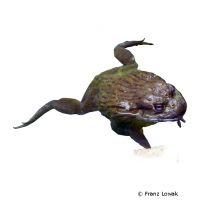African Bullfrog (Pyxicephalus adspersus)
| African Bullfrog Pyxicephalus adspersus | |
|---|---|
| Name | African Bullfrog |
| Name Lat. | Pyxicephalus adspersus |
| Family | True Frogs |
| Family lat. | Ranidae |
| Order | Frogs & Toads |
| Order lat. | Anura |
| Origin | Africa |
| Habitat | Savanna |
| Diet | Carnivore |
| Humidity | 70-100 % |
| Behavior | ♂ territorial |
| Keeping | Individual, pair |
| Care Level | Difficult |
| Breeding | Moderately difficult |
| Housing | Humid terrarium |
| Life Span | 10-15 years |
| Protection | No |
| Metric Units | |
| Size | 24 cm |
| Temperature | 24-30 °C |
| Housing Size | 60 x 60 x 50 cm |
| US Units | |
| Size | 9.4" |
| Temperature | 75-86 °F |
| Housing Size | 25" x 25" x 20" |
Distribution and habitat
The crepuscular to nocturnal African bullfrogs are native to parts of central and southern Africa. They inhabit savannah areas and coastal plains near rainy season pools and other small water bodies. As cultivators, they also live in gardens and fields.
Maintenance
For 1 animal, the minimum area of the terrarium is 3,600 cm² with a minimum effective height (measured without substrate) of 40 cm. This corresponds to a base area of e.g. 60 x 60 cm, for 2 animals at least 70 x 60 cm. The terrarium should be placed in a quiet place without sunlight.
You need a terrarium with a 15-20 cm deep substrate of loose, absorbent, non-rotting substrate such as sand-peat mixture, coconut fibers or sphagnum moss with a drainage, plus pieces of bark, flat stones, strongly branched climbing branches, preferably entwined with climbing plants, a dense planting (e.g. Tradescantia, Ficus, Hoya, Bromeliads) and a shallow water basin. Potted plants that can be easily removed for cleaning are advantageous. At least twice a day, except during seasonal dry periods, the inside of the terrarium must be finely sprayed with water (humidity), but a rain or mist system is better
| Temp. day: 24-30 °C | Temp. night: 20-22 °C | Humidity: 70-100 % |
The lighting duration must be 10-14 hours depending on the season. Very suitable are daylight fluorescent tubes with low UV content, supplemented with spotlights.
During the seasonal dry period (about 3 months) the humidity is reduced to 50-80 % and the temperature is lowered.
Diet
In nature, they feed on creatures that they can overpower and fit in their mouths. The food supply consists of live insects such as crickets, grasshoppers and crickets, as well as mealybug larvae and cockroaches, and occasionally mice according to their size. Often, special ready-made food for insectivores is also accepted. Food should be offered to adult animals 2-3 times a week, young animals must be fed daily. It is important to add minerals and vitamins regularly (e.g. by dusting the food animals).
A varied diet promotes health and prevents deficiency symptoms.
Reproduction and breeding
Females are much smaller than males at about 13 cm. Males are olive colored and have a yellow-orange throat area.
They spawn up to 4,000 eggs in small bodies of water formed during heavy rains and lay them freely in small pads in the water. Males guard and defend the clutch until development is complete. After 1-2 days the larvae hatch and after 15-20 days the transformation (metamorphosis) is complete and the frog leaves the water.
Life expectancy can be over 12 years.
Important
During dry dormancy, they bury themselves and form a cocoon of skin to avoid drying out. In nature, the spawning season is triggered by heavy rains. Males behave very territorial and aggressive during the mating season
Before purchasing, a terrarium should be prepared that meets the species specific needs. Good ventilation without drafts and equipment for measuring temperature and humidity are necessary. The lighting has to correspond to the species-specific day-night rhythm and should be placed in such a way that the animals cannot injure themselves. The terrarium should be locked in such a way that neither unauthorized persons can open it nor the animals can escape. Special attention must be paid to thorough hygiene and impurities must be removed regularly
Further literature can be found in your pet store.
References
Text: petdata; Image: Franz Lowak
Source: VDA & DGHT (2006): Haltungsrichtlinien für die Haltung von Anuren; ENGELMANN (2006): Zootierhaltung - Tiere in menschlicher Obhut: Reptilien und Amphibien, Harri Deutsch Verlag; HANS-JOACHIM HERRMANN (2005): Terrarienatlas Bd. 2, Mergus Verlag
- Gemäß § 21 Abs. 5 Tierschutzgesetz idgF
